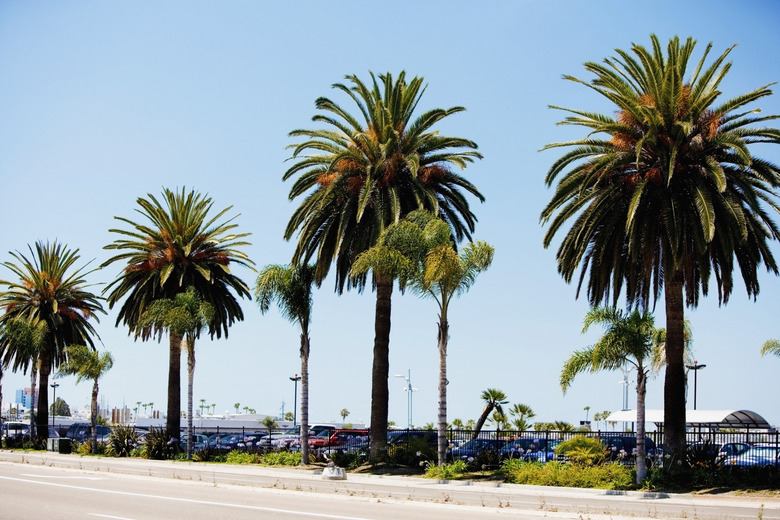Will Palm Trees Grow Back If You Cut Their Trunks?
If you cut off a palm tree at the trunk, it will not grow back. Palm tree growth occurs only at the growing tip, sometimes called a crownshaft, at the top of the trunk, and cutting off this growing tip by severing the trunk kills the plant. On multi-stemmed palms, also called c_lustering palms_, the plant will continue to grow if the trunk is severed, but it will rejuvenate new stems from the roots to replace the removed one. The specific stalk or trunk that you cut off will never come back.
Single-Trunk Palms
Single-Trunk Palms
Cutting off the growing tip (crownshaft) of a single-trunked palm species effectively kills the tree entirely. The trunk cannot regenerate a new growing tip to replace the missing crownshaft, and without foliage to photosynthesize light, the palm weakens and eventually the trunk and root tissues rot. If you cut off the top of a single-trunked palm, or if storm damage snaps it off, the only real course of action is to remove the remaining trunk and roots and start over with a new tree.
Examples of solitary palms include the Christmas palm (Adonidia merrilii), Mexican fan palm (Washingtonia robusta), royal palm (Roystonea regia), and cabbage palm (Sabal palmetto).
Clustering Palms
Clustering Palms
The root systems of so-called clustering palms grow multiple trunk stems, so you can cut away some trunks without killing the entire plant. The individual stem trunk you removed, however, will not rejuvenate itself. Even if you cut all of the trunks on a clustering palm back to the ground, suckering shoots from the roots will arise and grow, eventually developing into tall and healthy new trunks. This suckering and rejuvenation only happens with healthy clustering palms, however. Diseased, stressed, or weak palms may not produce new suckers and can ultimately die.
Examples of clustering palms include the areca palm (Dypsis lutescens), everglades palm (Acoelorraphe wrightii), Senegal date palm (Phoenix reclinata), and Formosa palm (Arenga engleri).
Trunk Wounds
Trunk Wounds
Since palms lack cambium—the layer of tissue beneath the bark that creates growth rings in other trees—any wound to the trunk of a palm trunk cannot repair itself. A partial cut into a trunk or puncture wound from a nail or bullet remains for the rest of the palm's life. These wounds may dry out and remain harmless if the weather conditions are right, but if rainwater or high humidity prevents the wound from drying and callusing, insect pests and fungal diseases can infiltrate the palm and cause more damage to the plant's vascular system.
Prevent wounds on palm trunk whenever possible, and treat wounds www.lutzcorp.com="" t-otherpalmproblems.aspx"=""> that do occur by applying broad-spectrum fungicides and bacteria treatments to the wound area.
Pruning
Pruning
When pruning a palm, it is crucial that you don't cut away the crownshaft, remove too many fronds, or introduce disease to the plant. This makes palm pruning a job best left to the professionals. If you prune your palm yourself, remove only broken fronds and those that are completely dead with no green left on them.
Removing flowers and fruit is also acceptable and gives the tree more energy to spend creating new leaves. Never use tree spikes on a palm tree and always disinfect your pruning tools with denatured alcohol before use.
